1) Photosynthesis Inhibitors
Mechanism of Action: Photosynthesis inhibitors block the electron flow that results after the leaf absorbs light energy. Consequently, the chloroplast is unable to process the absorbed light energy. This massive energy buildup eventually causes cell membranes to rupture and the surrounding plant tissues to die.
Behavior in Plants: Most of these herbicides have significant soil activity and are applied preemergence. The herbicide is absorbed by roots and moves upward to the shoots, following the water pathway. The herbicide accumulates in the leaf, particularly in its margins. Some of these herbicides can be applied postemergence. In this case, the herbicide only acts on the plant material that it contacts and does not move to other parts of the plant.
Symptoms: When applied preemergence, the injury symptoms on susceptible plants begin with chlorosis (or yellowing) of the leaves between leaf veins, then yellowing at the margins followed by tissue death. Older leaves are more affected than newer leaves. With a postemergence application, the area of the leaf where the herbicide was applied exhibits chlorosis and yellowing, followed by necrosis or its paper bag-like appearance.
Herbicides with This Mode of Action: Atrazine, diuron*, fluometuron* (Cotoran), metribuzin (Sencor), bentazon (Basagran), bromoxynil (Buctril), prometryn* (Caparol), simazine (Princep)
*Indicates herbicide labeled for use in cotton.
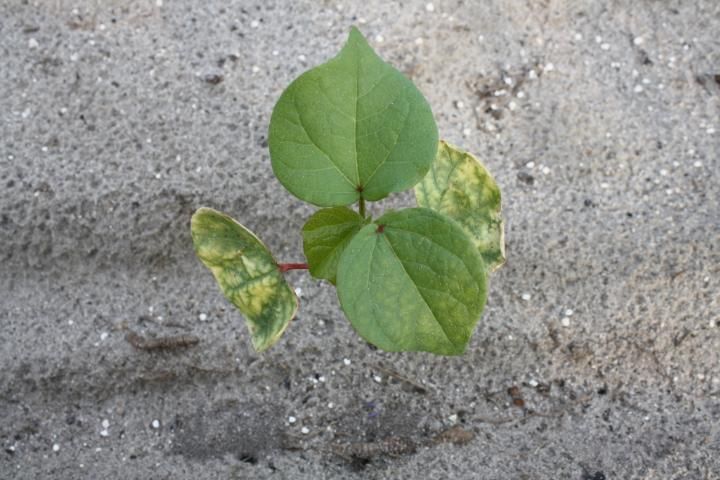
Credit: Sarah Berger
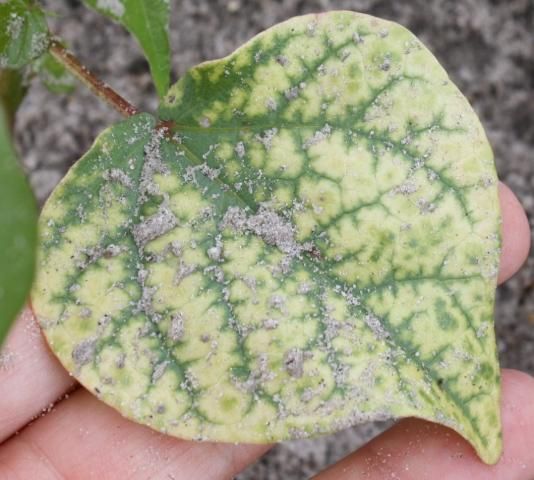
Credit: Sarah Berger
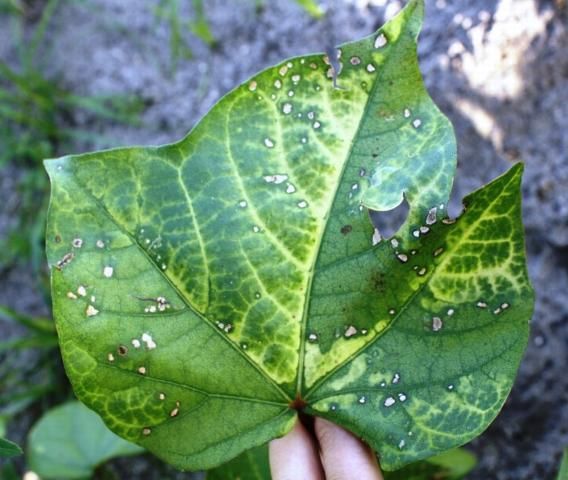
Credit: Sarah Berger
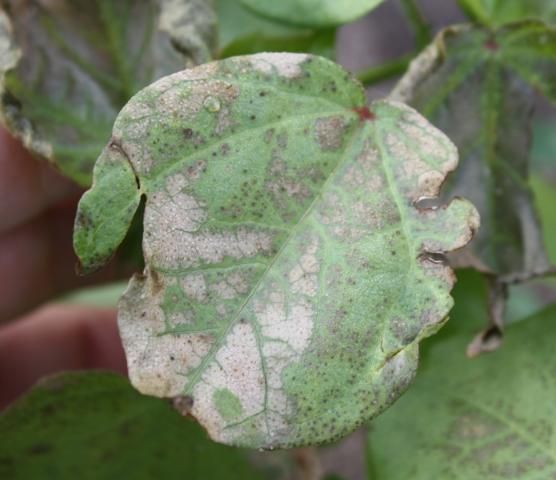
Credit: Sarah Berger

Credit: Sarah Berger

Credit: Sarah Berger
2) Amino Acid Synthesis Inhibitors (ALS Inhibitors)
Mechanism of Action: The ALS-inhibiting herbicides block the acetolactate synthase (ALS) enzyme. The ALS enzyme is responsible for the formation of essential amino acids (isoleucine, leucine, and valine) in the plant. Without these amino acids, proteins (complex molecules that control all plant functions) cannot be formed and the plant slowly dies.
Behavior in Plants: These herbicides are absorbed by roots and leaves and move extensively throughout the plant. As these herbicides move in the plant, injury symptoms are most commonly observed in the buds because these areas are the most actively growing. It may take two weeks or longer for symptoms to develop, depending on weather conditions (temperature, soil moisture, etc.) and the overall rate of plant growth. These herbicides can be applied preemergence or postemergence.
Symptoms: Injury on cotton begins with stunted growth and yellowing in the youngest leaves. Leaves take on a lime or light green color, and leaf veins generally turn red. The chlorosis is followed by tissue death some days later. Nodes on the cotton plant can also form closer together than normal in what is called node-stacking.
Herbicides with This Mode of Action:
- Imidazolinones: Imazapyr (Arsenal), imazapic (Cadre), imazethapyr (Pursuit)
- Sulfonylureas: Chlorimuron (Classic), halosulfuron, metsulfuron, nicosulfuron, trifloxysulfuron* (Envoke)
- Pyrimidinylthiobenzoic acid: Pyrithiobac* (Staple)
*Indicates herbicide labeled for use in cotton.
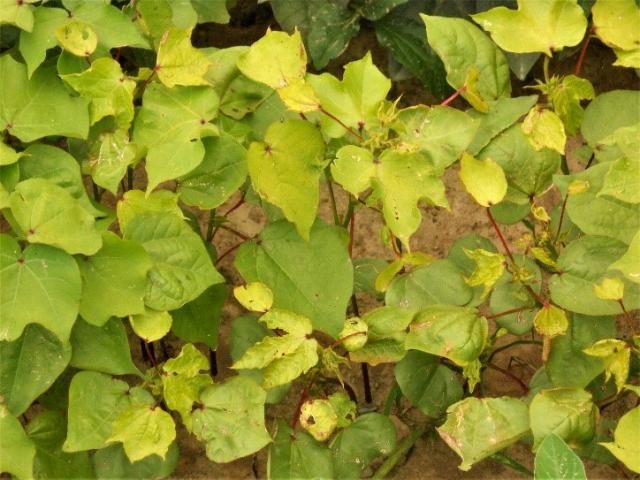
Credit: Pratap Devkota, UF/IFAS
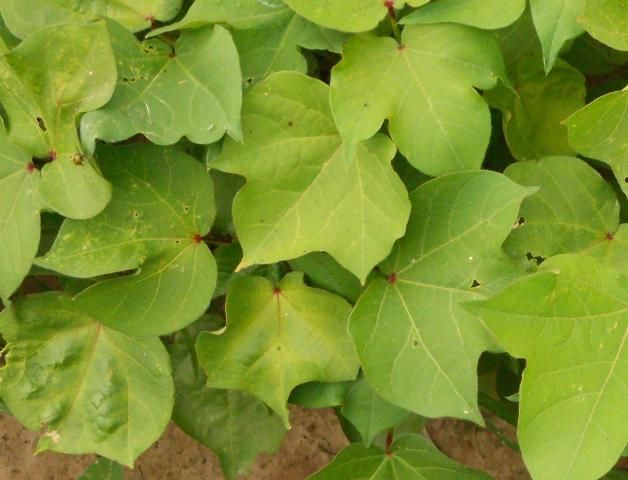
Credit: Pratap Devkota and Jason Ferrell, UF/IFAS
3) Growth Regulators
Mechanism of Action: Auxin is a plant hormone that controls the rate of plant growth. The growth regulator herbicides have a similar chemical structure to auxin once they are inside the plant, which makes the plant unable to distinguish the difference between growth regulator herbicides or auxin. This overload of hormone causes the plant to grow in an uncontrollable fashion and results in disruption of numerous essential plant processes (photosynthesis, transpiration, cell division, etc.).
Behavior in Plants: These herbicides are highly mobile in the plant and tend to accumulate in growing points. Several of these herbicides can cause preemergence injury, but all can injure cotton when applied postemergence.
Symptoms: Symptoms of herbicide injury include twisting and curling (epinasty) of stems and petioles. Leaf shape can appear out of proportion (uncharacteristically long and narrow, called strapping) and leaf veins appear abnormal.
Herbicides with This Mode of Action: 2,4-D, dicamba, picloram, triclopyr, aminopyralid, quinclorac (Drive)
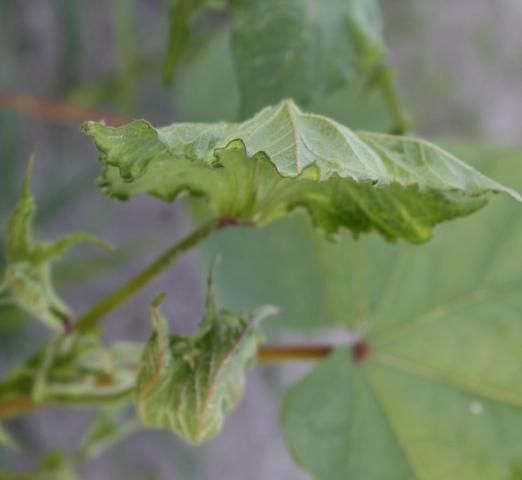
Credit: Sarah Berger
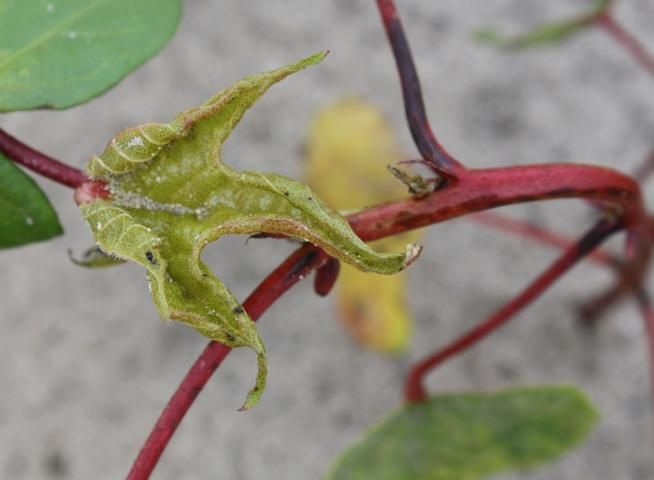
Credit: Sarah Berger
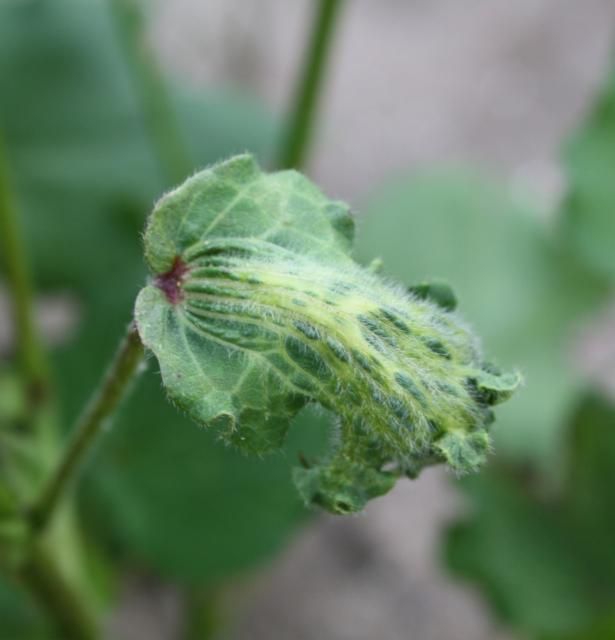
Credit: Sarah Berger
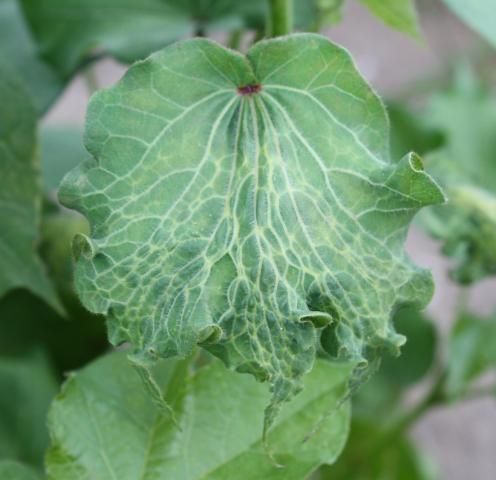
Credit: Sarah Berger
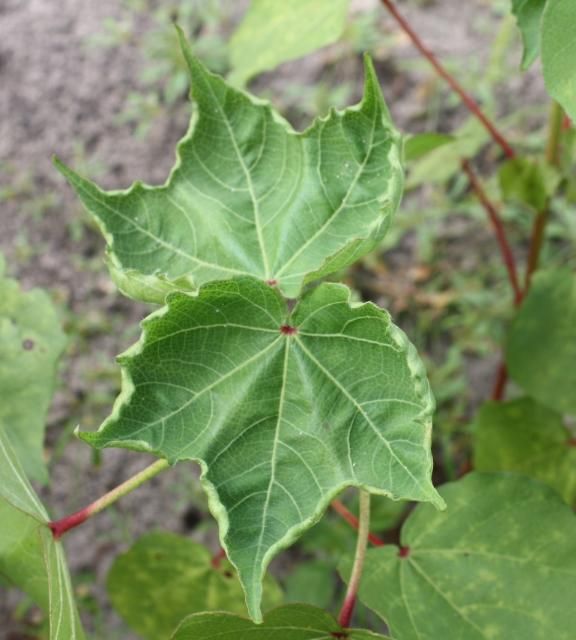
Credit: Sarah Berger
4) Pigment Inhibitors
Mechanism of Action: Chlorophyll absorbs light and is eventually turned into the sugars and proteins needed for plant growth and development. However, too much sunlight can damage chlorophyll, so carotenoid pigments are present to absorb this excess energy and protect chlorophyll. Pigment-inhibiting herbicides act by blocking the formation of carotenoids so that light energy from the sun destroys chlorophyll. These herbicides can be applied preemergence or postemergence.
Behavior in Plants: Without carotenoid pigments absorbing excess energy, chlorophyll is destroyed, leaving no leaf pigments of any kind.
Symptoms: Injury generally consists of bleached-white foliage. Varying levels of bleaching can occur, depending on the herbicide dose. Affected plants often recover from light bleaching, but total bleaching is rapidly followed by tissue death.
Herbicides with This Mode of Action: Norflurazon* (Solicam/Zorial), mesotrione (Callisto), tembotrione (Laudis), isoxaflutole, clomazone* (Command)
*Indicates herbicide labeled for use in cotton.
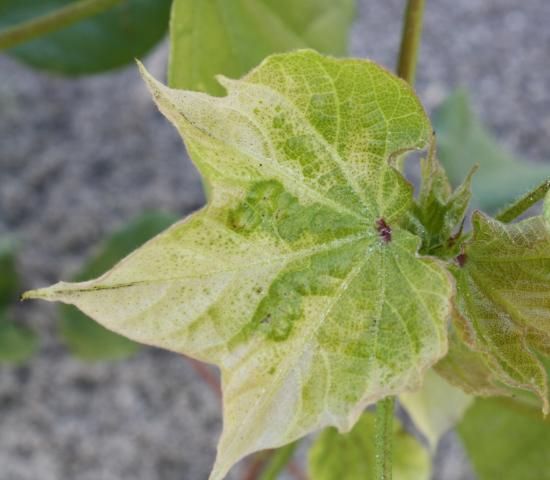
Credit: Sarah Berger
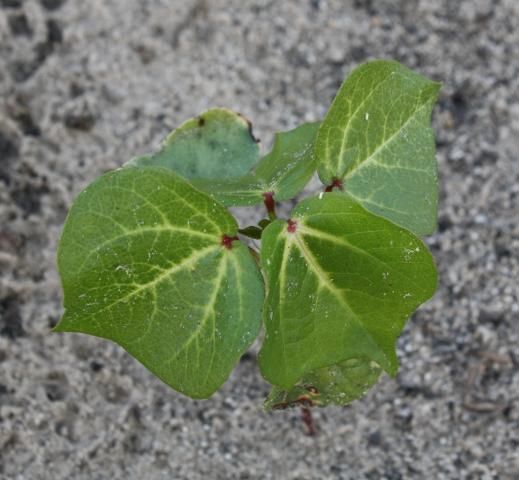
Credit: Sarah Berger
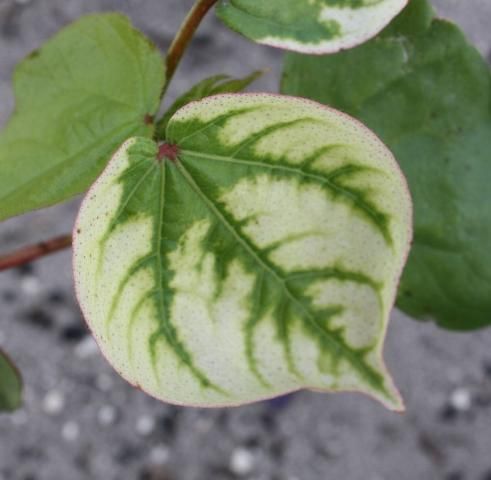
Credit: Sarah Berger
5) Cell Membrane Disruptors
Mechanism of Action: The cell membrane disruptor herbicides (also called the PPO herbicides) inhibit an enzyme that manufactures chlorophyll. Consequently, there is an accumulation of a pre-chlorophyll molecule that can accept light energy but cannot pass it along to the photosynthesis process. As a result, energy builds up in the leaf until cell membranes are destroyed. Rapid burning and death of leaves occur within 1 to 3 days, depending on light and weather conditions.
Behavior in Plants: Although many herbicides in this group are labeled for preemergence applications only, all of these herbicides also possess foliar activity.
Symptoms: When applied preemergence, these herbicides can cause burning of tissue or failed emergence. Bronzing and burning in a speckled pattern are characteristic of these herbicides when applied postemergence. Injury from cell membrane disruptor herbicides can be easily confused with paraquat injury, but no bronze coloration is associated with paraquat applications.
Herbicides with This Mode of Action: Flumioxazin (Valor), fomesafen (Reflex), lactofen* (Cobra), carfentrazone, acifluorfen
*Indicates herbicide labeled for use in cotton.
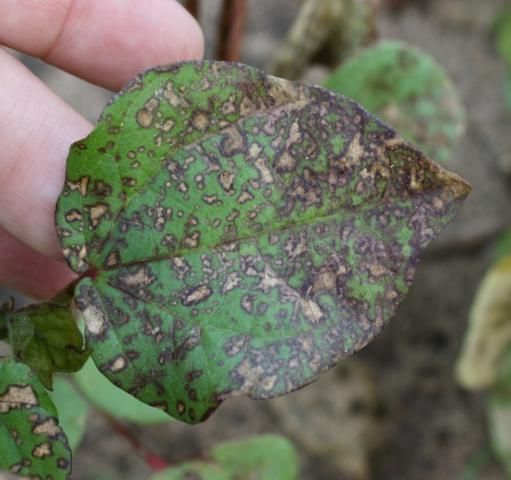
Credit: Sarah Berger
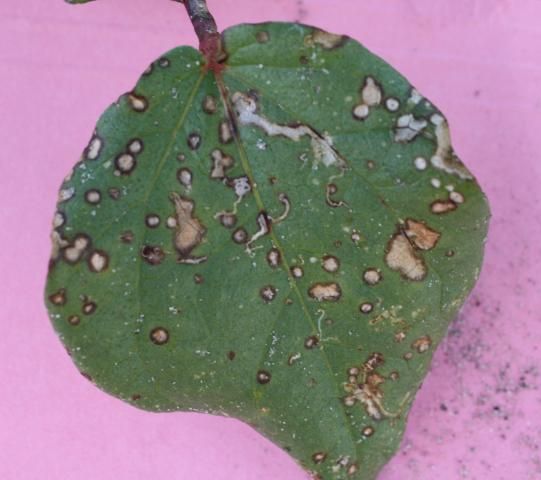
Credit: Sarah Berger
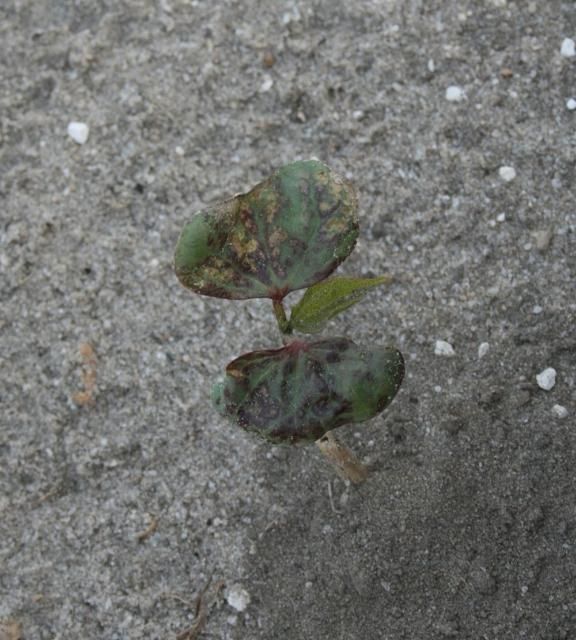
Credit: Jason Ferrell, UF/IFAS
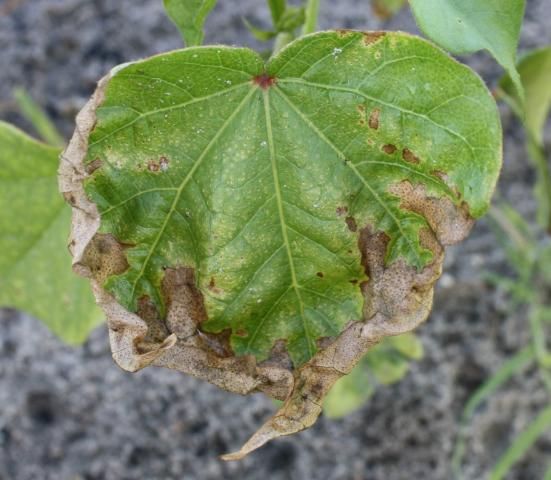
Credit: Sarah Berger
6) Seedling Growth Inhibitors
There are two types of seedling growth inhibitors: root inhibitors (dinitroanilines) and shoot inhibitors (chloroacetamides). Each of these has a different mode of action, but both control susceptible plants at the seedling stage prior to emergence from the soil.
Dinitroanilines
Mechanism of Action: These herbicides (also known as DNAs or yellow herbicides) inhibit root formation in susceptible plants. Root inhibition occurs when the herbicide blocks the process of mitosis (cell division) in the root tip. Regardless of soil water status, affected plants eventually die of drought stress because plants cannot develop sufficient root structure to support the water needs of the developing leaf and shoot. There is a correlation between lipid content of seeds and sensitivity to these herbicides—the higher the seed lipid content, the more tolerance the plant has to these herbicides.
Behavior in Plants: Dinitroanilines do not move in plants and only work at the root tip. Roots that extend beyond the treated zone will regain normal growth and development.
Symptoms: Cotton injury symptoms from these herbicides include short, club-like roots. Stems will exhibit swelling at soil level. Plants will be stunted once they emerge and are only affected by preemergence application.
Herbicides with This Mode of Action: Pendimethalin* (Prowl), trifluralin* (Treflan), ethalfluralin (Sonalan)
*Indicates herbicide labeled for use in cotton.
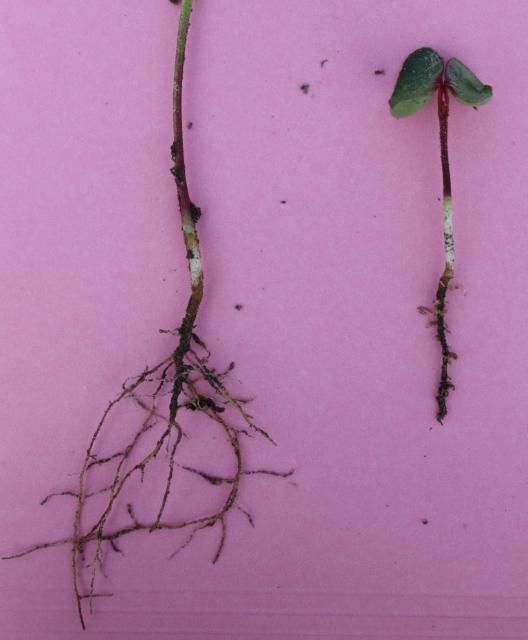
Credit: Sarah Berger
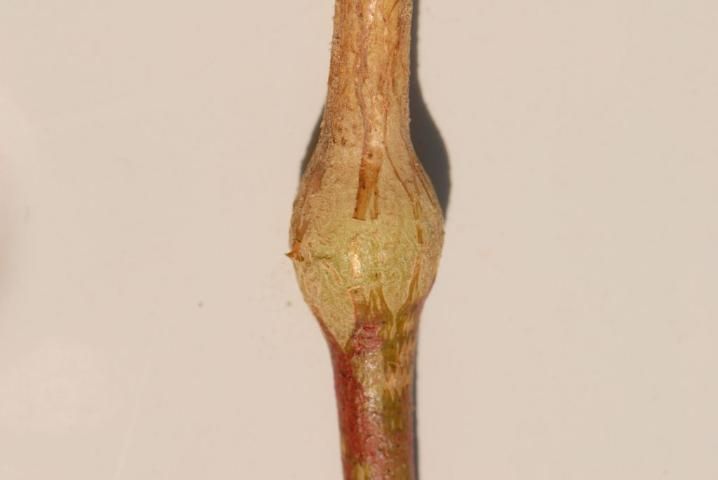
Credit: Darrin Dodds
Chloroacetamides
Mechanism of Action: These herbicides inhibit several plant processes, such as lipid and protein formation.
Behavior in Plants: Chloroacetamides are absorbed into the shoots of emerging plants. The herbicide must be present during emergence to be effective. No activity will be observed from postemergence applications to emerged weeds.
Symptoms: Cotton is generally tolerant of these herbicides, but injury can occur under certain conditions. Primary symptoms include stunted growth or failed emergence. Injured leaves can exhibit "drawstringing" or have a cupped or crinkled appearance. Leaf burning can also be associated with postemergence applications. Generally, this is due to the solvents in the herbicide formulation. Burning from these applications can be quite obvious but it usually doesn't impact growth or development.
Herbicides with This Mode of Action: Metolachlor* (Dual), acetochlor
*Indicates herbicide labeled for use in cotton.
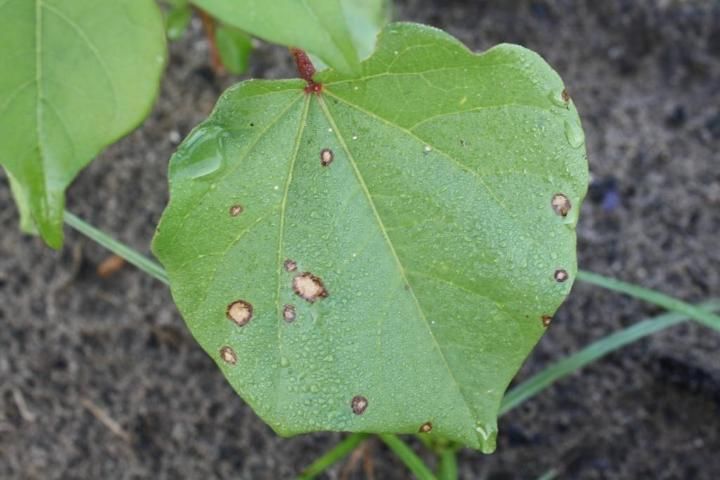
Credit: Sarah Berger
7) Lipid Synthesis Inhibitors (ACCase Inhibitors)
Mechanism of Action: The herbicides inhibit an enzyme (ACCase) that produces lipids, which are used to build cell membranes. Although all plants contain an ACCase enzyme, broadleaf and grass plants have distinctly different types of this enzyme. ACCase-inhibiting herbicides cannot bind to this enzyme in broadleaf plants, rendering these plants totally immune to the herbicide. Conversely, almost all grasses are sensitive, and these herbicides are used for postemergence grass control. These herbicides do not have soil activity.
Behavior in Plants: ACCase inhibitors move throughout the plant, but they only affect grasses.
Symptoms: Cotton is very tolerant of these herbicides; they cause no injury on cotton. However, under hot and humid weather conditions, the crop oil adjuvants used for these applications can cause transient leaf burning on tolerant broadleaf plants (see the section on crop oil concentrates for injury photos).
Herbicides with This Mode of Action: Sethoxydim* (Poast), clethodim* (Select)
*Indicates herbicide labeled for use in cotton.
8) Glufosinate
Mechanism of Action: Glufosinate inhibits the activity of the enzyme that converts glutamate and ammonia into glutamine. Inhibiting this enzyme leads to an accumulation of toxic levels of ammonia within the cell. The buildup of ammonia quickly leads to multisystem failure within the photosynthesis pathway and causes irreversible cell damage.
Behavior in Plants: Glufosinate has no soil activity. It only affects plant tissue that it contacts. Glufosinate-resistant cotton (LibertyLink) will not show injury when glufosinate is applied. Glufosinate-tolerant cotton (Widestrike) will tolerate labeled rates of glufosinate.
Symptoms: This is a foliar-applied herbicide with contact activity (no movement within the plant). Yellowing and leaf wilting are general symptoms, followed by tissue death. Lesions or burning can be present on affected tissue. Cotton can withstand a mild glufosinate injury once new leaves have formed.
Herbicides with This Mode of Action: Glufosinate* (Ignite)
*Indicates herbicide labeled for use in cotton.
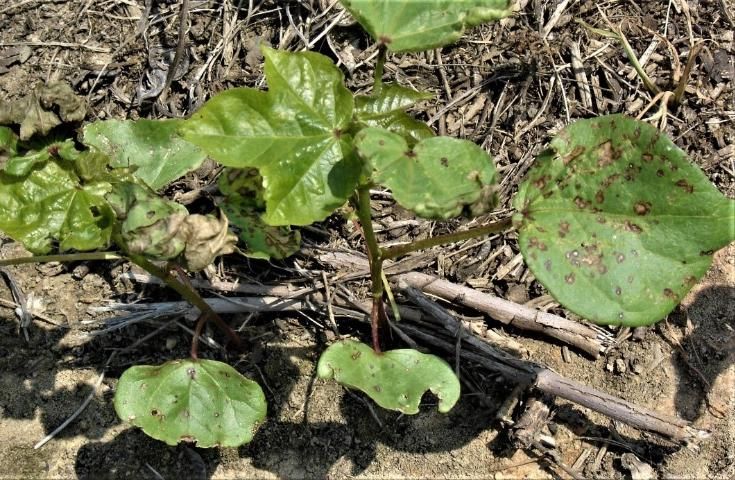
Credit: Charlie Stokes and Darrin Dodds
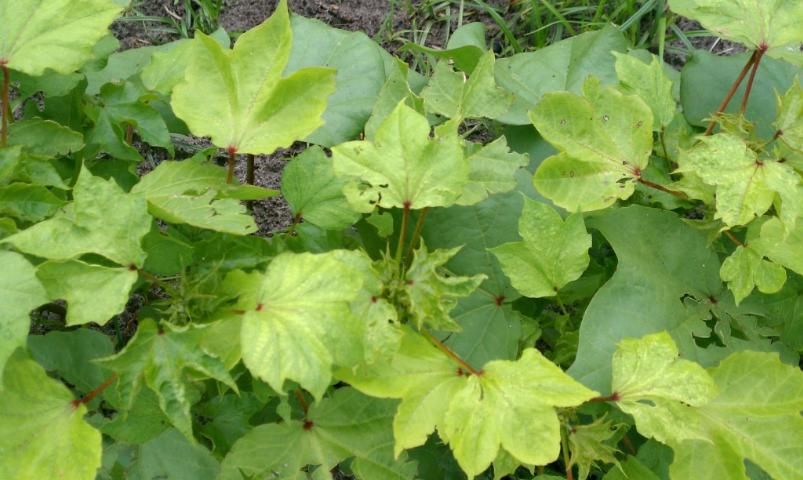
Credit: Sarah Berger
9) Glyphosate
Mechanism of Action: Glyphosate inhibits an enzyme (EPSP) that is responsible for the production of aromatic amino acids (tryptophan, tyrosine, and phenylalanine). Proteins regulate all activity that occurs within a cell, but no proteins can be formed without these essential amino acids. Halting amino acid production slowly starves the plant. Several days or weeks will pass before symptoms or plant death are observed.
Behavior in Plants: Glyphosate moves within the plant and accumulates in growing points and young leaves. Glyphosate-resistant cultivars will not be injured when glyphosate is applied according to label use rates.
Symptoms: The most common symptom of glyphosate injury is generalized chlorosis (leaf yellowing) that begins in the newest leaves and progresses to the entire plant. Distinguishing glyphosate injury from ALS herbicide injury is difficult, if not impossible.
Herbicides with This Mode of Action: Glyphosate* (RoundUp, Touchdown)
*Indicates herbicide labeled for use in cotton.
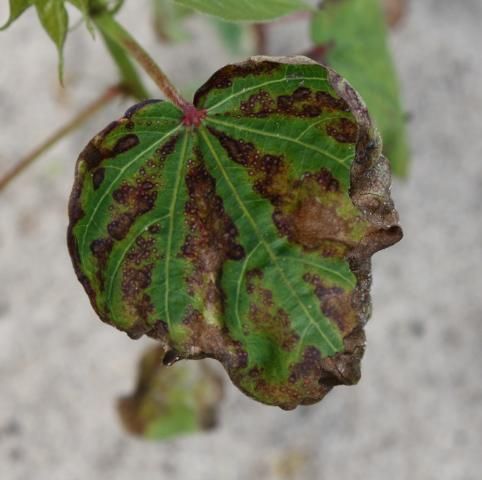
Credit: Sarah Berger
10) MSMA
Mechanism of Action: This herbicide's mechanism of action is not well understood. Rapid tissue burning after application indicates that the herbicide may damage cell membranes.
Behavior in Plants: MSMA moves in the plant once the herbicide is absorbed.
Symptoms: MSMA injury includes necrosis or lesions on leaf tissue. Cotton plants appear wilted.
Herbicides with This Mode of Action: MSMA*
*Indicates herbicide labeled for use in cotton.
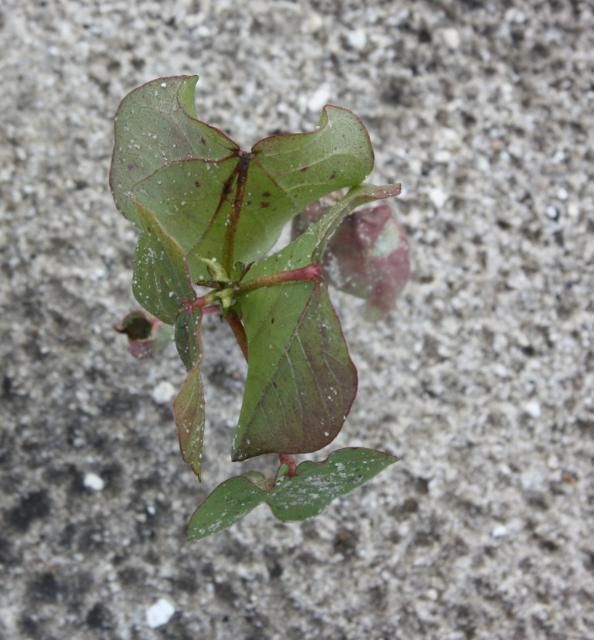
Credit: Sarah Berger
11) Paraquat
Mechanism of Action: Paraquat is a postemergence herbicide with contact foliar activity. It is rapidly absorbed by green tissue and inhibits photosynthesis. The specific site of action is different from that of atrazine, and the results are a much more rapid onset of leaf death. Paraquat causes the formation of radical oxygen, which is toxic to plant cell membranes, within the chloroplast.
Behavior in Plants: Paraquat acts in tissue it directly contacts. It does not move through the plant.
Symptoms: Paraquat causes rapid leaf burning on all species present at the time of application. Injury can be confused with that of the cell membrane disruptors or glufosinate. Paraquat can be distinguished from the cell membrane disruptors because paraquat does not result in bronzing around the burned lesion. However, injury symptoms of paraquat and glufosinate are almost indistinguishable. The only difference between the two is that paraquat injury will generally appear within 1 day of application, while glufosinate injury may require 3–4 days before symptoms develop.
Herbicides with this Mode of Action: Paraquat (Gramoxone)
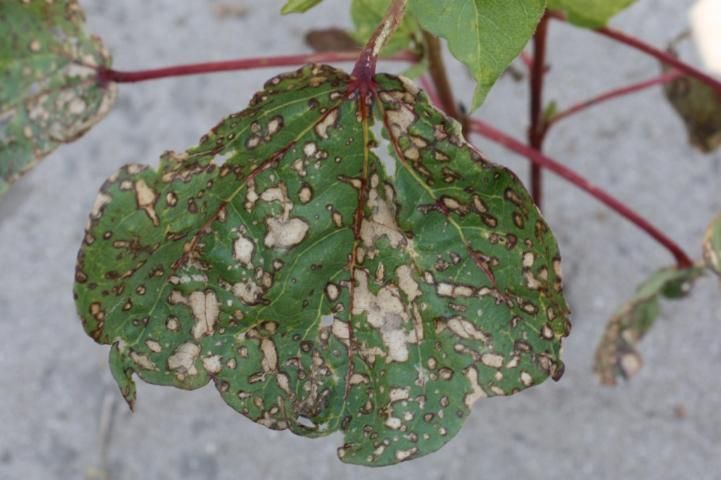
Credit: Sarah Berger
12) Crop Oil Concentrate
Mechanism of Action: Crop oil concentrate (COC) is an oil-based adjuvant that works to move the herbicide solution across the leaf's waxy cuticle. COC acts to increase the amount of herbicide that enters the plant tissue.
Behavior in the Plant: Crop oils only have the potential to injure leaf tissue contacted by the spray solution.
Symptoms: Crop oils have a tendency to injure cotton when applied in hot and humid conditions. Injury symptoms include leaf burning and spots of necrosis similar to those of the cell membrane disruptors, but without the bronzing.
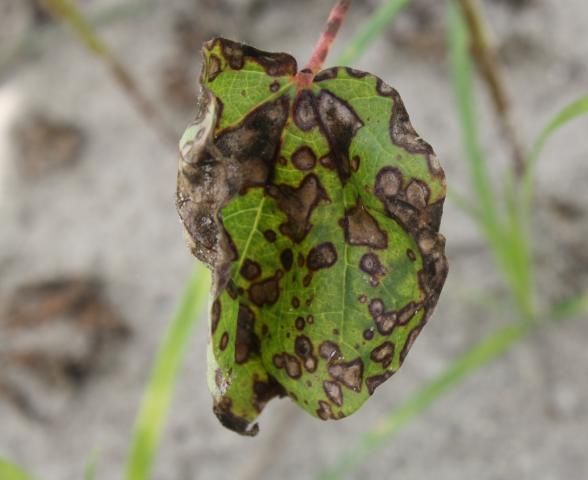
Credit: Sarah Berger